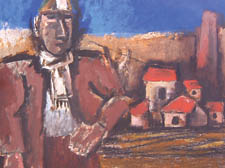|
|
 |
| |
‘In life, we are all beginners’
?A new book and exhibition have sparked a revival of interest in Josef Herman, a ‘most wonderful man’ who painted life in the raw, writes Gerald Isaaman
The Art and Life of Josef Herman. By Monica Bohm-Duchen. Lund Humphries
HE was the artist who devoted his great talent to those at the coal face of life, going down the pits in South Wales to draw the miners trapped in their dark tunnels of unrelenting work. He pictured Scottish fishermen toiling at sea, Mexican peasants slaving in their fields, grape-pickers in Burgundy, sheep shearers in Suffolk.
It was the proud and pathetic poor that filled his canvas. And, in the city, he watched the tennis stars smashing balls at Wimbledon, footballers battling for Wembley cup success, and carnival workers at the colourful Notting Hill displays.
Beyond that, he enjoyed the simple beauty of nature, capturing the magic of birds and trees in luminous detail.
Throughout his life, Josef Herman, the painter from Poland who grew up in poverty in Warsaw before trekking across Europe to escape Nazi persecution and the gas chambers, dignified the integrity of the human condition.
For him the workers, the grafters, deserved their own pedestal, as he portrayed them in his dynamic drawings and bold brush-stroked paintings that shouted out their unmitigated message, as in his Festival of Britain mural of miners.
Herman hated artistic celebrity, though he enjoyed the friendship of Jacob Epstein and LS Lowry, shunned fame, though it caught him in later life. He became an RA, was awarded an OBE and accolades galore. Now, almost a decade after his death, aged 89, two events, backed by the added international flavour of his travels, have brought his memory and remarkable art back to life.
They are very much local. And rightly so. Herman may not be a familiar name in celebrity art world of today, with its unmade beds and pickled sharks. Yet the impact he made was tremendous, its stark simplicity and vibrant realism making you catch your breath.
The events that have coalesced to restore his reputation are the publication of a beautifully produced biography, The Art and Life of Josef Herman, and an exhibition at the Boundary Gallery, Swiss Cottage.
Plans are under way for a retrospective exhibition of his art, possibly at National Museum of Wales – all thanks to the combined efforts of local people Monica Bohm-Duchen, author of the biography who lives in Hampstead, Herman’s long time friend Agi Katz of the Boundary Gallery, Josef’s widow Nini, now in Golders Green, and his son David, living in West Hampstead.
This is all the more appropriate since Herman lived and worked for 11 years in Fellows Road, Hampstead, in particular at the time he was “discovered” by the late Hampstead art dealer Gustav Delbanco. It was a period similar to that spent living alongside among the Welsh miners of Ystradgynlais.
“This is a remarkable occasion,” says Agi Katz, who curated Herman’s first show at the Ben Uri Gallery in London, and has organised the current tribute exhibition at the Boundary Gallery, her 10th show of his work.
“I so admired his art and what he had to say about life, never ever using long words, his insight into poverty and childhood, and art itself.
“We lunched every six weeks for 18 years, often at a working man’s cafe where he liked the simple things, such as scrambled eggs, or in an Italian restaurant where they called him Maestro.
“He cut himself off from society because he said you had to drink with rich people if you want to get on. And he despised those who crowed about their financial success. He was, for me, a most wonderful man.”
And so he was for art historian Monica Bohm-Duchen, who first approached Herman in 1987 for his co-operation in writing a monograph. But he declined, declaring: “Why on earth do I need to get a foothold on the vanity history – the immortality industry?”
So her project lay dormant until Herman’s family invited her to go ahead three years ago, giving her the opportunity to follow his life’s trail from Warsaw to Brussels, Paris, Glasgow, Ystradgynlais, Suffolk and London – and even to the island of Skye.
“His heyday was in the 40s and 50s,” she says. “Then there was something of an eclipse in his career. So now I hope that young people can be encouraged to see his work, and to realise what a major artist of integrity he was, a man of real humanity, modesty and importance we need to remember.”
She quotes a note he wrote at 73 to explain his indomitable spirit: “Only the years of living and what we make of them as long as we are alive, this alone can be meaningful, even worthwhile. Yet in this we are all beginners.”
And she reveals how equally eloquent Herman was with words, forever unsure and insecure, wondering whether to be a poet or a painter.
Josef Herman may have hidden himself away, believing he missed his target, but he created a great living picture of life in the raw. As John Berger insisted: “I take it for granted that Herman is one of the most important painters working here.”
•
•
|
 |
|
 |
 |
|
 |
|


